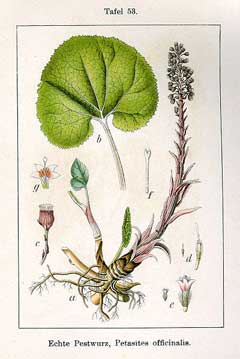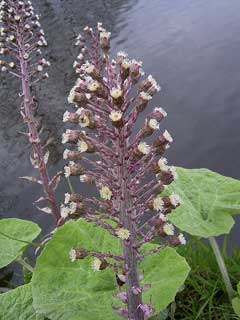 |
|
http://commons.wikimedia.org/wiki/File:Petasites_hybridus_Sturm53.jpg |
 |
| http://commons.wikimedia.org/wiki/User:TeunSpaans |
Translate this page:
Summary
Physical Characteristics

 Petasites hybridus is a PERENNIAL growing to 1 m (3ft 3in) by 3 m (9ft) at a fast rate.
Petasites hybridus is a PERENNIAL growing to 1 m (3ft 3in) by 3 m (9ft) at a fast rate.
See above for USDA hardiness. It is hardy to UK zone 4. It is in leaf from April to December, in flower from March to May. The species is dioecious (individual flowers are either male or female, but only one sex is to be found on any one plant so both male and female plants must be grown if seed is required). and is pollinated by Insects. The plant is not self-fertile.
Suitable for: light (sandy), medium (loamy) and heavy (clay) soils. Suitable pH: mildly acid, neutral and basic (mildly alkaline) soils. It can grow in full shade (deep woodland) semi-shade (light woodland) or no shade. It prefers moist or wet soil.
UK Hardiness Map
US Hardiness Map
Synonyms
P. officinalis. P. ovatus. P. vulgaris. Tussilago petasites. T. hybrida.
Plant Habitats
Woodland Garden Dappled Shade; Shady Edge; not Deep Shade; Meadow; Bog Garden;
Edible Uses
References More on Edible Uses
Medicinal Uses
Plants For A Future can not take any responsibility for any adverse effects from the use of plants. Always seek advice from a professional before using a plant medicinally.
Analgesic Antispasmodic Appetizer Cardiotonic Diaphoretic Diuretic Homeopathy Urinary
Butterbur is widely considered to be an effective cough remedy and recent experiments have shown it to have remarkable antispasmodic and pain-relieving properties[244]. It acts specifically on the bile ducts, stomach and duodenum[254]. The plant contains pyrrolizidine alkaloids, in isolation these are toxic to the liver[254]. The root and the leaves are analgesic, antispasmodic, cardiotonic, diaphoretic and diuretic[4, 9]. A decoction is taken as a remedy for various respiratory problems such as asthma, colds, bronchitis and whooping cough and also other complaints such as fevers and urinary complaints[4, 254]. It is also very effective in the treatment of gastrointestinal complaints and biliary dyskinesia[244, 254]. Externally it can be used as a poultice to speed the healing of wounds and skin eruptions[254]. The leaves are harvested in early summer, the root in late summer to autumn. Both can be dried for later use[9]. Because the plant contains potentially toxic alkaloids its internal use cannot be recommended[254]. A homeopathic remedy is made from the roots[4]. It is used in the treatment of severe and obstinate neuralgia[4]. Petasites hybridus (commonly known as butterbur) contains pyrrolizidine alkaloids (PAs), which can be hazardous. These compounds are toxic to the liver and can cause serious side effects, including liver damage, hepatic veno-occlusive disease, and even an increased risk of cancer with prolonged exposure. Because of this, raw or unprocessed butterbur extracts are unsafe for internal use. Commercial butterbur preparations that are marketed for migraines, hay fever, or asthma are often labeled “PA-free”, meaning the pyrrolizidine alkaloids have been removed through processing. Only these PA-free extracts are considered safe for short-term use, and even then, they should be taken with medical guidance.
References More on Medicinal Uses
The Bookshop: Edible Plant Books
Our Latest books on Perennial Plants For Food Forests and Permaculture Gardens in paperback or digital formats.

Edible Tropical Plants
Food Forest Plants for Hotter Conditions: 250+ Plants For Tropical Food Forests & Permaculture Gardens.
More

Edible Temperate Plants
Plants for Your Food Forest: 500 Plants for Temperate Food Forests & Permaculture Gardens.
More

More Books
PFAF have eight books available in paperback and digital formats. Browse the shop for more information.
Shop Now
Other Uses
References More on Other Uses
Cultivation details
Succeeds in ordinary garden soil[1], but prefers a deep fertile humus-rich soil that is permanently moist but not stagnant, succeeding in shade, semi-shade or full sun[200]. Requires a moist shady position[187]. Plants can be grown in quite coarse grass, which can be cut annually in the autumn[233]. A very invasive plant, too rampant for anything other than the wild garden[187, 200]. Its roots are very difficult to eradicate[200]. It is best to only grow the male form in the garden to prevent unwanted seedlings popping up all over the place[200]. The growth is so dense and vigorous, with large leaves that can be 75cm or more across, that virtually no other plant is able to grow amongst this species[4]. Plants are a useful early nectar source for bees[200]. Dioecious, male and female plants must be grown if seed is required.
References Carbon Farming Information and Carbon Sequestration Information
Temperature Converter
Type a value in the Celsius field to convert the value to Fahrenheit:
Fahrenheit:
The PFAF Bookshop
Plants For A Future have a number of books available in paperback and digital form. Book titles include Edible Plants, Edible Perennials, Edible Trees,Edible Shrubs, Woodland Gardening, and Temperate Food Forest Plants. Our new book is Food Forest Plants For Hotter Conditions (Tropical and Sub-Tropical).
Shop Now
Plant Propagation
Seed - we have no information on this species but suggest sowing the seed in a cold frame as soon as it is ripe or in early spring. Only just cover the seed and do not allow the compost to dry out. When they are large enough to handle, prick the seedlings out into individual pots and plant them out in the summer. Division succeeds at almost any time of the year. Very easy, larger divisions can be planted out direct into their permanent positions. We have found that it is better to pot up the smaller divisions and grow them on in light shade in a cold frame until they are well established before planting them out in late spring or early summer.
Other Names
If available other names are mentioned here
Native Range
TEMPERATE ASIA: Turkey (north), Russian Federation-Ciscaucasia (Ciscaucasia), Armenia, Georgia, Russian Federation (Dagestan) EUROPE: United Kingdom, Ireland, Austria, Belgium, Switzerland, Czech Republic, Germany, Hungary, Netherlands, Poland, Slovakia, Russian Federation (European part), Belarus, Moldova, Ukraine (incl. Krym), Albania, Bulgaria, Bosnia and Herzegovina, Greece, Croatia, Italy (incl. Sicily), North Macedonia, Montenegro, Romania, Serbia, Slovenia, Spain, France (incl. Corsica)
Weed Potential
Right plant wrong place. We are currently updating this section.
Please note that a plant may be invasive in one area but may not in your area so it's worth checking.
Conservation Status
IUCN Red List of Threatened Plants Status :

Growth: S = slow M = medium F = fast. Soil: L = light (sandy) M = medium H = heavy (clay). pH: A = acid N = neutral B = basic (alkaline). Shade: F = full shade S = semi-shade N = no shade. Moisture: D = dry M = Moist We = wet Wa = water.
Now available:
Food Forest Plants for Mediterranean Conditions
350+ Perennial Plants For Mediterranean and Drier Food Forests and Permaculture Gardens.
[Paperback and eBook]
This is the third in Plants For A Future's series of plant guides for food forests tailored to
specific climate zones. Following volumes on temperate and tropical ecosystems, this book focuses
on species suited to Mediterranean conditions—regions with hot, dry summers and cool, wet winters,
often facing the added challenge of climate change.
Read More
Expert comment
Author
(L.)P.Gaertn.,C.A.Mey.&Scherb.
Botanical References
17200
Links / References
For a list of references used on this page please go here
Readers comment
| Add a comment |
|
If you have important information about this plant that may help other users please add a comment or link below. Only comments or links that are felt to be directly relevant to a plant will be included. If you think a comment/link or information contained on this page is inaccurate or misleading we would welcome your feedback at [email protected]. If you have questions about a plant please use the Forum on this website as we do not have the resources to answer questions ourselves.
* Please note: the comments by website users are not necessarily those held by PFAF and may give misleading or inaccurate information.
To leave a comment please Register or login here All comments need to be approved so will not appear immediately.
|
Subject : Petasites hybridus
|
|
|
|